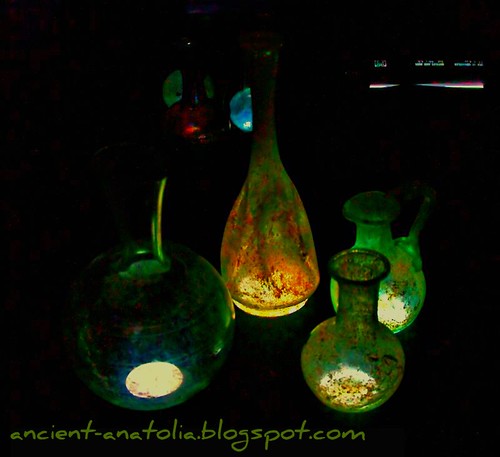
Ancient Glass Work at Bodrum Museum, originally uploaded by voyageAnatolia.blogspot.com.
Ancient glass work from 1400 BC to 1100 AD ancient cities of Kaunos and Stratonikea at Bodrum Museum of Underwater Archaeology.
Archaeological evidence suggests that the first true glass was made in coastal north Syria, Mesopotamia or Old Kingdom Egypt.
Because of Egypt's favorable environment for preservation, the majority of well-studied early glass is found there, although some of this is likely to have been imported. The earliest known glass objects, of the mid third millennium BCE, were beads, perhaps initially created as accidental by-products of metal-working (slags) or during the production of faience, a pre-glass vitreous material made by a process similar to glazing.
During the Late Bronze Age in Egypt (e.g., the Ahhotep "Treasure") and Western Asia (e.g. Megiddo) there was a rapid growth in glass-making technology. Archaeological finds from this period include colored glass ingots, vessels (often colored and shaped in imitation of highly prized hardstone carvings in semi-precious stones) and the ubiquitous beads. The alkali of Syrian and Egyptian glass was soda ash, sodium carbonate, which can be extracted from the ashes of many plants, notably halophile seashore plants. The earliest vessels were 'core-wound', produced by winding a ductile rope of glass round a shaped core of sand and clay over a metal rod, then fusing it with repeated reheatings. Threads of thin glass of different colors made with admixtures of oxides were subsequently wound around these to create patterns, which could be drawn into festoons by using metal raking tools. The vessel would then be rolled flat ('marvered') on a slab in order to press the decorative threads into its body. Handles and feet were applied separately. The rod was subsequently allowed to cool as the glass slowly annealed and was eventually removed from the center of the vessel, after which the core material was scraped out. Glass shapes for inlays were also often created in moulds. Much early glass production, however, relied on grinding techniques borrowed from stone working. This meant that the glass was ground and carved in a cold state.
By the 15th century BCE extensive glass production was occurring in Western Asia, Crete and Egypt and the Mycenaean Greek term ku-wa-no-wo-ko meaning "worker of lapis lazuli and glass" (written in Linear b syllabic script) is attested. It is thought the techniques and recipes required for the initial fusing of glass from raw materials was a closely guarded technological secret reserved for the large palace industries of powerful states. Glass workers in other areas therefore relied on imports of pre-formed glass, often in the form of cast ingots such as those found on the Ulu Burun shipwreck off the coast of modern Turkey.
Glass remained a luxury material, and the disasters that overtook Late Bronze Age civilizations seem to have brought glass-making to a halt. It picked up again in its former sites, in Syria and Cyprus, in the 9th century BCE, when the techniques for making colorless glass were discovered. The first glassmaking "manual" dates back to ca. 650 BCE. Instructions on how to make glass are contained in cuneiform tablets discovered in the library of the Assyrian king Ashurbanipal. In Egypt glass-making did not revive until it was reintroduced in Ptolemaic Alexandria. Core-formed vessels and beads were still widely produced, but other techniques came to the fore with experimentation and technological advancements. During the Hellenistic period many new techniques of glass production were introduced and glass began to be used to make larger pieces, notably table wares. Techniques developed during this period include 'slumping' viscous (but not fully molten) glass over a mould in order to form a dish and 'millefiori' (meaning 'thousand flowers') technique, where canes of multi-colored glass were sliced and the slices arranged together and fused in a mould to create a mosaic-like effect. It was also during this period that colorless or decolored glass began to be prized and methods for achieving this effect were investigated more fully.
According to Pliny the Elder, Phoenician traders were the first to stumble upon glass manufacturing techniques at the site of the Belus River. Georgius Agricola, in De re metallica, reported a traditional serendipitous "discovery" tale of familiar type:
"The tradition is that a merchant ship laden with nitrum being moored at this place, the merchants were preparing their meal on the beach, and not having stones to prop up their pots, they used lumps of nitrum from the ship, which fused and mixed with the sands of the shore, and there flowed streams of a new translucent liquid, and thus was the origin of glass."
This account is more a reflection of Roman experience of glass production, however, as white silica sand from this area was used in the production of glass within the Roman Empire due to its low impurity levels.
During the 1st century BCE glass blowing was discovered on the Syro-Palestinian coast, revolutionising the industry. Glass vessels were now inexpensive compared to pottery vessels. The conquest of Judea by the Romans in 63 BCE paved the way for the growth of the use of glass products that occurred throughout the Roman world. Glass became the Roman plastic, and glass containers produced in Judea and by the Jewish population in Alexandria spread through out the Roman Empire. With the discovery of clear glass (through the introduction of manganese oxide), by the Jewish glass blowers in Alexandria ca. 100 CE, the Romans began to use glass for architectural purposes. Cast glass windows, albeit with poor optical qualities, began to appear in the most important buildings in Rome and the most luxurious villas of Herculaneum and Pompeii. Over the next 1,000 years glass making and working continued and spread through southern Europe and beyond.
More about ancient glass production...